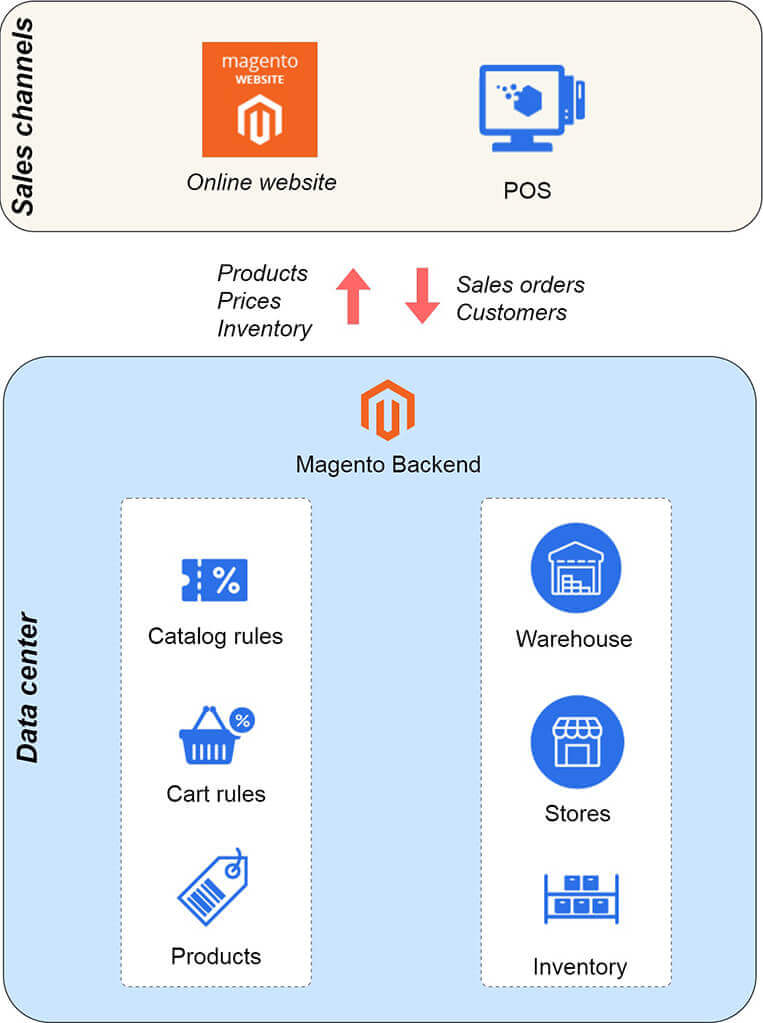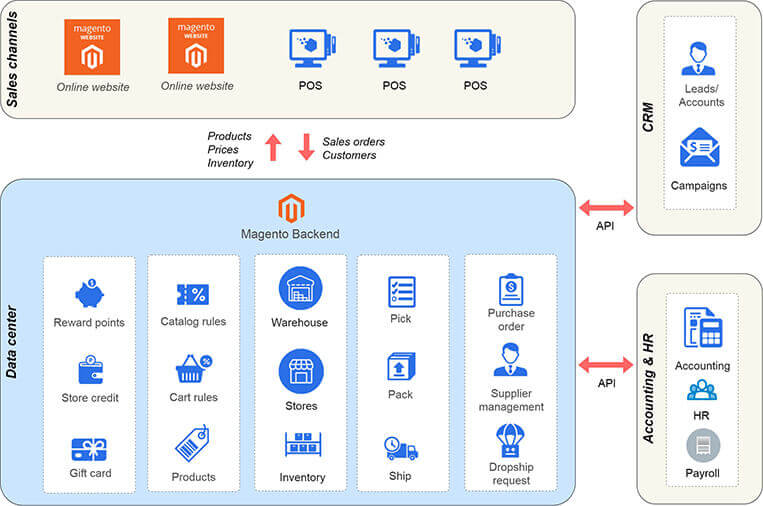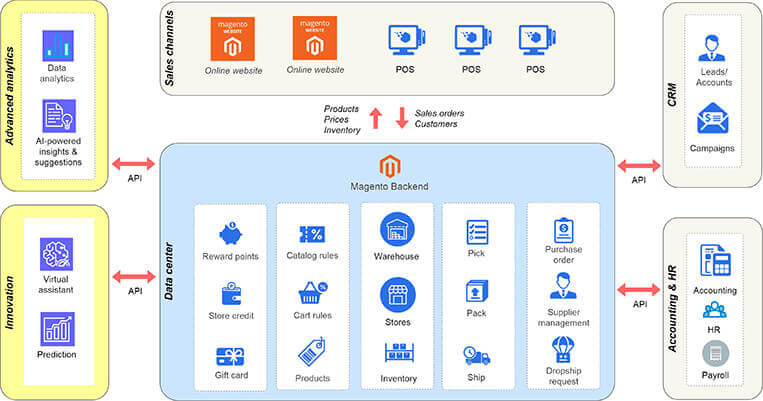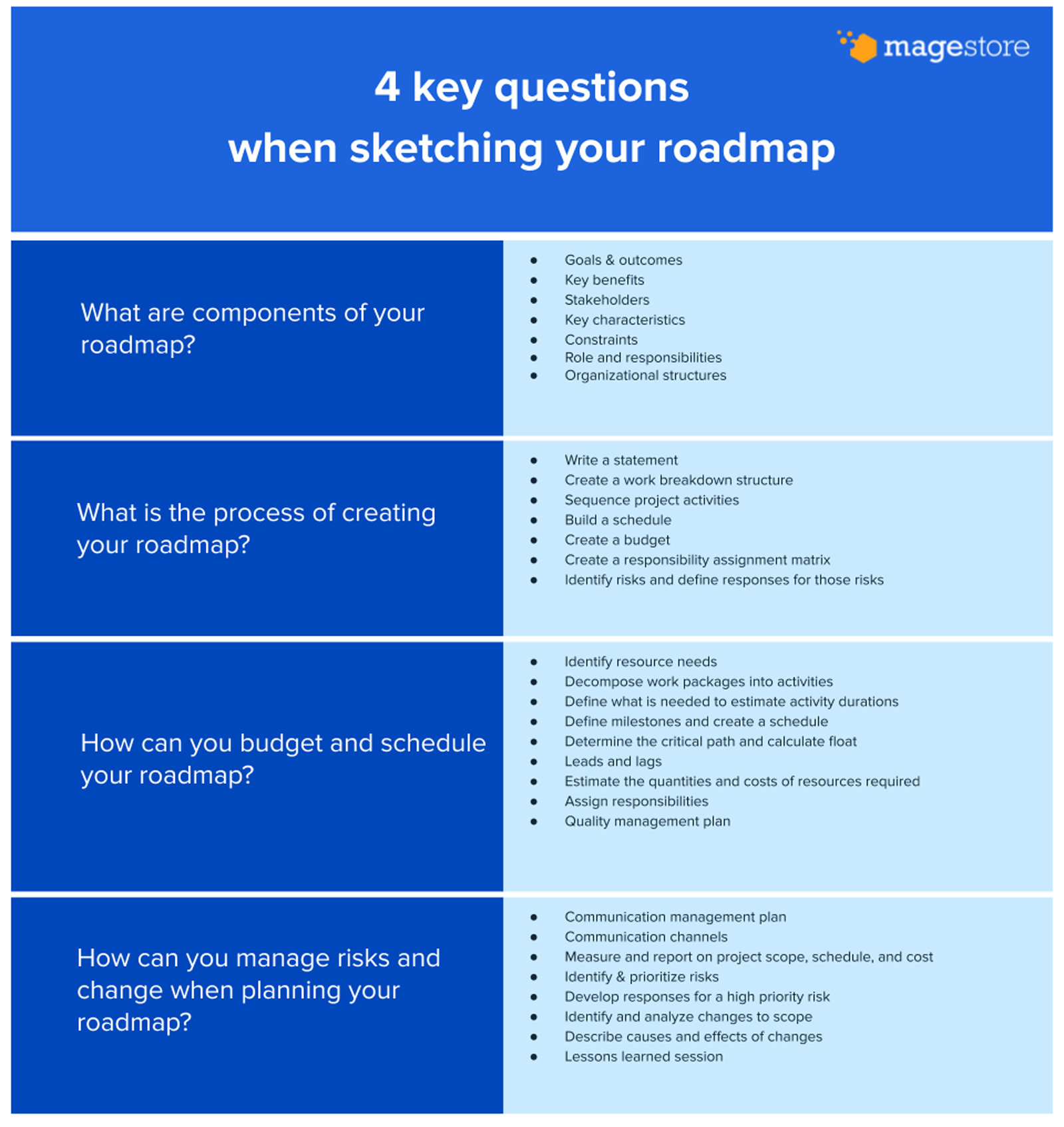Chapter 2: Sketch your winning model and roadmap
Omnichannel retail can be a long and winding road, filled with challenges and obstacles. However, with a good foundation, growing multi-store retailers can cut through complicated concepts and strategies and succeed. Start with identifying the path to omnichannel on Magento and where you are on the journey. From there you can design the roadmap that best fits your business.
Any growing retail goes through different maturity stages over its life cycle. Most retailers understand that operation and customer experience are the keys to a successful omnichannel program. However, in JDA’s 2017 retail survey, only 10% of retail executives felt they have refined their omnichannel delivery to the point where they were able to meet demand and make a profit.
To improve key capabilities, understanding your current state is vital. This helps you determine the next steps on your omnichannel growth and the end state, which does not have to be the highest level in the maturity model. Once you’ve identified where you are, a clear roadmap will be your golden compass to evolve through the maturity stages.
Maturity stages of the omnichannel model
5 key criteria of omnichannel maturity
There are several criteria to evaluate the maturity of omnichannel retail businesses:
- Strategy
Retailers in different stages of the omnichannel journey will target different goals and challenges. Retailers starting out might focus on products and transactions to build a strong foundation.
Once you start to scale, this might shift to a customer-centric focus. Positive customer experience can be a top priority and embedded in company culture. Evaluate your strategy will help you come up with a clear roadmap, plan, and timeline to go omnichannel.
- Process
Successful retailers develop and constantly improve business processes. They document repeatable operations. Workflows are proactively planned instead of reactive as an afterthought. Retailers should align their processes with customer journeys and resolve the gaps to optimize their business.
- System
Your retail management system can make or break your omnichannel business. Business in different stages might find different usage, integration, and scope when it comes to their system.
On the other hand, retailers need to consider legacy system when building a long-term strategy. As your business grows, your system might expand to include sales, inventory, purchasing, marketing, and more. How far down the maturity model can your system take you? For example, an open source platform, such as Magento, makes it easier to customize to fit specific requirements and give you complete control of your business.
Successful retailers can identify and close technology gaps, and ensure all operations are closely integrated.
- Data
In the digital age, the availability and usage of data play a key role in your success. You should have plans to collect and use customer data across channels. Some retailers also develop central dashboard and view analytics in one place. In addition, having qualitative and quantitative KPIs for all channels will drive your business performance.
- People
The skills and knowledge of your staff will determine the success of your retail. Your team could range from dozens to thousands of people. To implement a winning omnichannel business, they need to work collaboratively in an integrated manner.
In addition, retail is a constantly evolving industry. Your business needs to stay knowledgeable about best practices and commit to continuous learning. Training, conferences, and keeping up with industry news are must-haves to make sure all parts of your operations run smoothly.
Apply these criteria to your retail will help you position your current and future self on the omnichannel journey.
5 stages of omnichannel retail maturity
There are many maturity models to address omnichannel retail, from supply chain to customer experience. Most of these maturity models will follow 5 key stages:
- Stage 1: Siloed
- Stage 2: Early-stage omnichannel
- Stage 3: Mid-stage omnichannel
- Stage 4: Omnichannel
- Stage 5: Optimized omnichannel
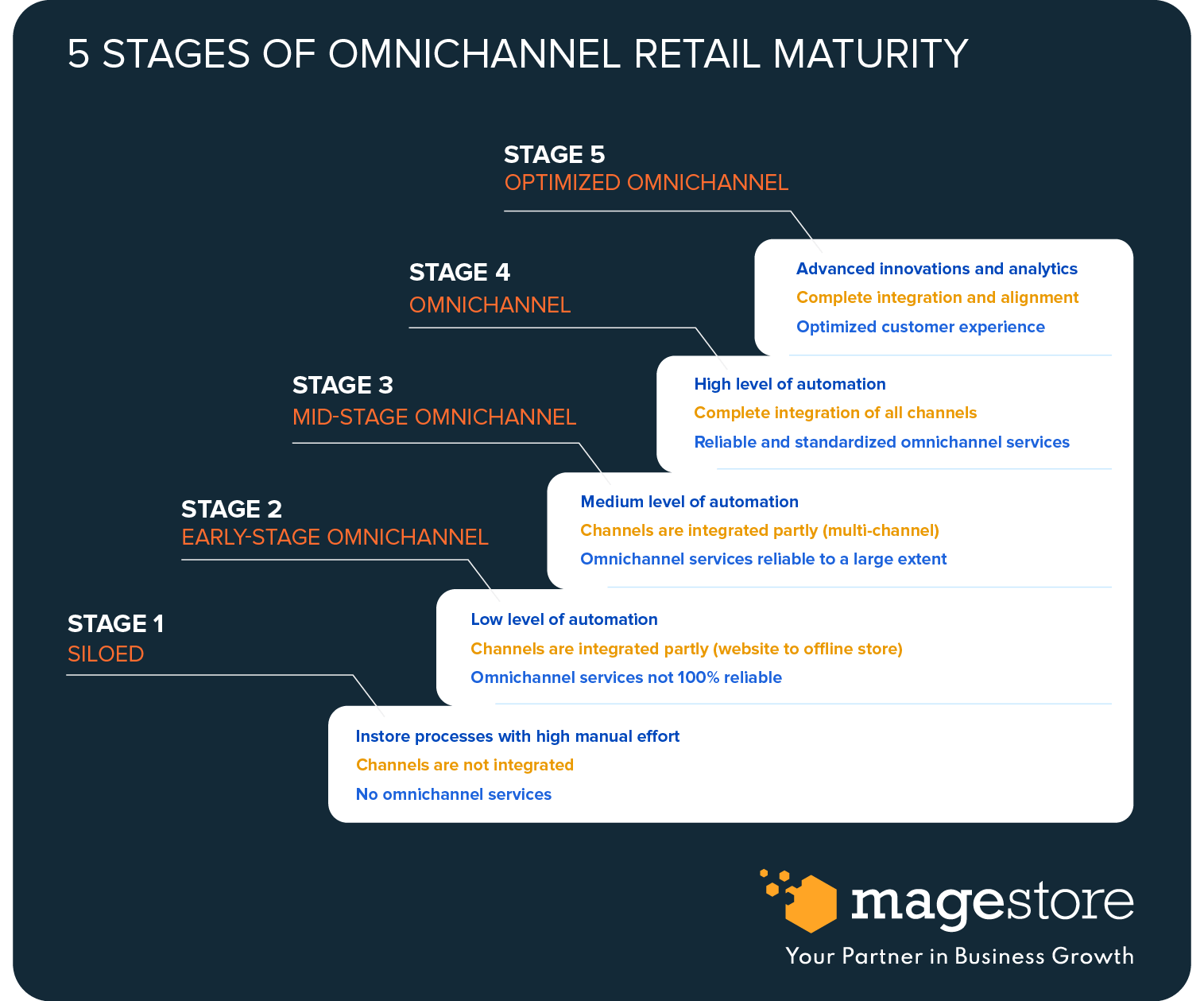
Can you identify your current stage of omnichannel maturity?
Stage 1: Siloed
In the first stage, retailer’s focus is product-centric and transactional. They only have basic supply chain processes and data flows in place. There’s no clear omnichannel strategy and operations are siloed.
For example, you may have a point of sale (POS) running in your retail store and a website, but they are not integrated. They have separate orders, customer data, and products. There are efforts to connect different parts of the system, but they are ad hoc and inconsistent.
Retailers might not have firm KPIs in place to track the effectiveness of their operation. Even if they do, retailers are suffering from low quality and incomplete data, as the databases are siloed.
Stage 2: Early-stage omnichannel
Retailers in early-stage omnichannel are shifting towards a customer-centric focus. You have an omnichannel strategy, roadmap, plan, and timeline in place. There’s integration between some channels. You have a basic view of the customer and offer a better experience.
An example would be a retail system where the online website, offline POS, and warehouse are connected. Order, customer, and product data can flow between these channels.
Businesses at this stage have started documenting retail processes. The staff are competent and minimum standards and best practices are emerging. Retailers are tracking performance with quantitative KPIs such as profitability.
Stage 3: Mid-stage omnichannel
Mid-stage omnichannel retailers embrace customer-centric values and contextual insights. There’s an emphasis on simplifying retail processes and aligning them to customer journeys. As a result, retail processes are more cohesive and strategic.
Mid-stage businesses dedicate resources to implementing best retail practices, training staff, and staying current. Internal operations are integrated and collaborate robustly to match customer expectations across all channels. Retail data begin to provide insights across some but not all channels. Tracking quantitative KPIs such as customer engagement is becoming more prominent.
Stage 4: Omnichannel
Omnichannel retailers embed customer-centric values in their culture. They deliver a consistently positive customer experience across channels. They enjoy a single and real-time view of order, inventory, product, customer, supplier, and more.
Omnichannel retailers test and iterate new techniques to improve their operations and enhance customer journey. Predictive analytics and customer experience KPIs begin to drive their next steps.
Stage 5: Optimized omnichannel
Retailers in this stage offer optimized customer experience with complete integration and alignment. Their team has an in-depth understanding of retail and their system. Optimized retailers continually review and innovate their process.
Their retail model is evolving as the industry grows. They are seeking cutting-edge retail technology and opportunities. These include cooperating with customers and partners to develop new services.
Omnichannel maturity assessment
Growing retails should assess their omnichannel maturity level to understand your current and desired state. The assessment results can explain where your company stands against your competition and guide your strategic plan in the right direction.
We based our assessment on the Compass Maturity Model from Manugistics, which classifies omnichannel retailers into 5 maturity levels. These maturity stages help you understand your position and what you need to improve to reach the next stage.
Growing retailers can evaluate their business across the 5 criteria mentioned above: Strategy, process, system, data, and people. Based on the results, you can define goals, develop a strategic plan, and create a roadmap for stronger retail operation and customer experience.
| Maturity stage | Business challenge | Change driver | Current focus | Roadmap and planning | Next focus |
|---|---|---|---|---|---|
| 1 | Cost of quality | Functional business process | Product-centric and transactional | No omnichannel management plan in place | Revise old business practices and commit to basic omnichannel offerings |
| 2 | Unreliable inventory and order fulfillment | Customer-centric business process and cost management | Awareness of customer orientation and basic view of customer | Omnichannel roadmap, plan, and timeline identified | Document and refine the operational processes that let you provide good customer experiences |
| 3 | Cost of customer service | End-to-end supply chain responsiveness | Customer-centric values and contextual insights | Omnichannel management plan for selected customer journeys implemented; later stages of roadmap now detailed | Improve customer experience capabilities, use contextual insights to better understand customer preferences and improve their experiences |
| 4 | Channel growth | Demand responsiveness and revenue growth | Customer oriented and aligned; customer-centric values fully embraced and embedded in the company culture | Omnichannel management covers all customer journeys; experiments identified to enhance the customer experience | Utilize predictive analytics to personalize interactions across the shopping journey |
| 5 | Enable customer journey | Consumer growth and retention | Customer oriented and aligned; continuous adaptation and focus on delivering positive outcomes proactively for customers | Continuous improvement and experimentation to enhance customer experience | Develop new services and expand into new industries |
| Maturity stage: 1 |
| Business challenge: Cost of quality |
| Change driver: Functional business process |
| Current focus: Product-centric and transactional |
| Roadmap and planning: No omnichannel management plan in place |
| Next focus: Revise old business practices and commit to basic omnichannel offerings |
| Maturity stage: 2 |
| Business challenge: Unreliable inventory and order fulfillment |
| Change driver: Customer-centric business process and cost management |
| Current focus: Awareness of customer orientation and basic view of customer |
| Roadmap and planning: Omnichannel roadmap, plan, and timeline identified |
| Next focus: Document and refine the operational processes that let you provide good customer experiences |
| Maturity stage: 3 |
| Business challenge: Cost of customer service |
| Change driver: End-to-end supply chain responsiveness |
| Current focus: Customer-centric values and contextual insights |
| Roadmap and planning: Omnichannel management plan for selected customer journeys implemented; later stages of roadmap now detailed |
| Next focus: Improve customer experience capabilities, use contextual insights to better understand customer preferences and improve their experiences |
| Maturity stage: 4 |
| Business challenge: Channel growth |
| Change driver: Demand responsiveness and revenue growth |
| Current focus: Customer oriented and aligned; customer-centric values fully embraced and embedded in the company culture |
| Roadmap and planning: Omnichannel management covers all customer journeys; experiments identified to enhance the customer experience |
| Next focus: Utilize predictive analytics to personalize interactions across the shopping journey |
| Maturity stage: 5 |
| Business challenge: Enable customer journey |
| Change driver: Consumer growth and retention |
| Current focus: Customer oriented and aligned; continuous adaptation and focus on delivering positive outcomes proactively for customers |
| Roadmap and planning: Continuous improvement and experimentation to enhance customer experience |
| Next focus: Develop new services and expand into new industries |
Guideline for growing multi-store retailers using Magento
The cornerstone to omnichannel success is to deliver relevant and personalized experiences across touchpoints. The key to achieving this is data organization. Retailers need to synthesize customer data from different applications and channels to create a comprehensive profile of each consumer.
Accordingly, we suggest 3 main steps to turn your Magento into an omnichannel system:
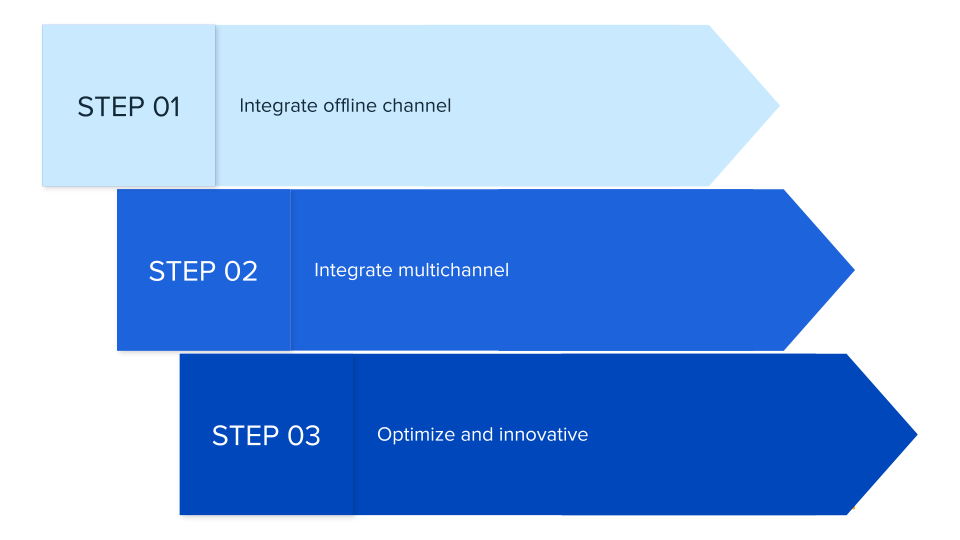
3 steps to apply maturity stages to your Magento system
Retailers should begin by integrating offline sales channels with Magento. This allows all data to synchronize from offline channels to the Magento database. After this, you’ll need to integrate with other channels in the supply chain. The final step is to optimize and innovate retail operation.
Let’s go into the details of each step.
Step 1: Integrate offline channels with Magento
To integrate Magento with offline channels, you can use a Magento-native POS or an integrated POS. However, a native solution delivers a more consistent experience for your customers.
This POS also needs to connect with Magento stocks in Inventory Management or Multi Source Inventory (MSI). The transactions from POS should be updated to Magento sales orders. With this, merchants can access all order data in one place.
Step 2: Integrate multichannel for seamless digital and physical experience
In the second step, retailers need to integrate Magento with other operations such as loyalty program and fulfillment. To manage purchasing and order processing, we recommend using a native solution built in Magento. It connects directly to Magento inventory sources and sales orders. This way, the data is updated instantly across the whole system, as well as on the sales channels.
Step 3: Optimize and innovate your operation
In the third stage, retailers should have all data from different channels in Magento. They can now focus on contextual insights with advanced analytics. Investing in innovative technology will create services that can set retailers apart from competitors.
Omnichannel roadmap design
There’s so much to coordinate and track to get from Point A to Point B. Retailers should break their omnichannel roadmap into smaller, more digestible phases.
There are 5 main phases when executing a roadmap:
- Initiating
- Planning
- Executing
- Controlling
- Closing

Project management life cycle by Jason Westland
Phase 1. Initiation
This is where everything begins. In this phase, you should determine your roadmap value and feasibility. You should analyze the strengths and weaknesses of all your channels and, more importantly, evaluate the state of the cross-channel strength. All the workflows and discrepancies between internal and external systems should be clarified.
In addition, competition analysis is important to realize the opportunities and challenges that you might face in the market. All these efforts are crucial to working out the channels to focus on and how to integrate the whole system.

Figure out an objective for your omnichannel implementation
Before the roadmap is approved or rejected, business owners should create two documents to present to stakeholders or sponsors:
- Business case: The need for the roadmap, including an analysis on return on investment
- Feasibility study: Evaluate roadmap goals, timeline to completion, and cost. You should also identify what resources will be required to fulfill the project, and if they are financially viable.
Phase 2. Planning
If the roadmap is approved, the next step is to assemble a team to achieve its goals within budget and timeline. You should involve various departments such as marketing, IT, project management, and customer success to create a comprehensive plan.

Create smaller goals within your big project
Roadmap planning should address the following aspects:
- Scope: Reiterate the need for the project, its deliverables, and objectives
- Definition: Break down the larger deliverables into smaller ones, which will help with managing them
- Tasks: Identify what tasks are necessary to produce the deliverables. Pay attention if any tasks are dependent on other tasks
- Schedule: Determine the duration of the tasks and set dates for their completion
- Resource: Since omnichannel is a complex implementation process, you should take into consideration professional services from external sources.
- Technology: As far as retail efficiency is concerned, an integrated platform is crucial for omnichannel success.
- Cost: Estimate the costs throughout your omnichannel implementation and formulate a budget
- Quality: Setup clear quality objectives and how to monitor them throughout the implementation process
- Organization: Note the organization and process to build your omnichannel system, including reporting on progress
- Staff: Determine roles and responsibilities of the project team
- Communications: Decide how to communicate information: what information, to whom, and how often
- Risk: Determine potential risks, how they’ll impact the project, and how to resolve them
Phase 3. Execution
Now that you’ve done your planning, it’s time to start building. Follow the plan you created, assign the tasks to your department, and monitor their progress with tools such as a project management dashboard.
This is where the rubber hits the road, but that doesn’t mean you’re just cruising. Given the complexity of your internal and external systems and unpredictable user interactions, implementing a flawless omnichannel strategy may seem hard. However, with a dedicated team (and professional solution partners), you can deploy omnichannel and achieve success.

Create real-time visibility and lower project risk
For example, some departments in your company may not have an opinion on omnichannel. It’s essential that each and every member should be aware of the targets and related responsibilities omnichannel brings. This includes personnel from all levels, from the executive managers to customer relations, sales, IT, marketing, business analysts, and more. The management and marketing teams can play a strategic role in bringing everyone on board with your omnichannel roadmap.
Phase 4. Monitor and Control
Constant review and adjustment are must-haves to ensure that you’re actualizing your omnichannel roadmap. Here are the aspects to consider:
- Reporting: Set up metrics to measure progress and a tool to deliver this information
- Scope: Monitor scope and control changes
- Quality: Measure the quality of deliverables and make sure that the planned quality is being met. If not, evaluate how to improve the quality
- Schedule: Keep track of delays or blocks that impact the project timeline and adjust to stay on track
- Cost: Monitor expenses and control cost changes
- Risk: Keep a changelog caused by risks throughout the project and respond accordingly

Create real-time visibility and lower project risk
There are several different approaches that retailers can take to manage their risks through their omnichannel implementation. Here are two popular methods:
- Traditional, sequential methodologies, such as waterfall and critical path method (CPM). These approaches are usually best suited to projects that produce physical and tangible products.
- Agile methodologies, such as scrum, kanban, extreme programming, and adaptive project framework. These methodologies were originally created for software developers and most suitable for projects that may have to change tasks or priorities.
Phase 5. Close
This final phase may also be called the follow-up phase. It involves:
- Make sure the roadmap deliverables have been completed as planned
- Close all outstanding contracts and administrative matters
- Archive the paperwork and disseminate to your stakeholders

Evaluate performance and share the takeaways to handle the next stage in a better way
Once your first roadmap is complete, you should set aside some time to evaluate key takeaways and recognize valuable team members. It will help you to approach the next omnichannel maturity stages with more enthusiasm and dedication.
Sample omnichannel roadmap for growing retails
Magestore has experience working with numerous merchants in different industries and scopes. Our processes and best practices have taken years to develop and have been proven across many successful growing retails. Here is a sample roadmap developed for one of our customers.
| Stage | Overview | Value for your business | Value for your customers |
|---|---|---|---|
| Stage 1: Online experience |
Improve customer experience on desktop and mobile eCommerce site:
|
Increased average order value, engagement, and conversion. Reduced time-intensive labor associated with manual merchandising and marketing. | Easy product and catalog discovery. Frictionless purchase. |
| Stage 2: Offline integration |
Integrate offline channel for better customer insights:
|
Better view of customer behaviors and enhanced targeting. | More relevant experience for customers shopping both online and offline. |
| Stage 3: Seamless digital |
Optimize online experience:
|
Coordinated experiences across different touchpoints. | Consistent and cohesive experience irrespective of device or location. |
| Stage 4: Seamless physical experience |
Create advanced omnichannel experience in-store:
|
Reduced friction between the customer and your staff, resulting in new and meaningful sales. | Worthwhile experiences with in-store and help center. |
| Stage 5: Omnichannel innovation |
Test and deploy innovative technology to interact one-on-one with customers in real-time:
|
Differentiation from competitors by offering brand experiences that are relevant to individual shoppers. | Inspiring and engaging experiences that are tailored to individual taste. |
| Stage 1: Online presence |
| Overview: Improve customer experience on desktop and mobile eCommerce site:
|
| Value for your business: Increased average order value, engagement, and conversion. Reduced time-intensive labor associated with manual merchandising and marketing. |
| Value for your customers: Easy product and catalog discovery. Frictionless purchase. |
| Stage 2: Offline integration |
| Overview: Integrate offline channel for better customer insights:
|
| Value for your business: Better view of customer behaviors and enhanced targeting. |
| Value for your customers: More relevant experience for customers shopping both online and offline. |
| Stage 3: Seamless digital |
| Overview: Optimize online experience:
|
| Value for your business: Coordinated experiences across different touchpoints. |
| Value for your customers: Consistent and cohesive experience irrespective of device or location. |
| Stage 4: Seamless physical experience |
| Overview: Create advanced omnichannel experience in-store:
|
| Value for your business: Reduced friction between the customer and your staff, resulting in new and meaningful sales. |
| Value for your customers: Worthwhile experiences with in-store and help center. |
| Stage 5: Omnichannel innovation |
| Overview: Test and deploy innovative technology to interact one-on-one with customers in real-time:
|
| Value for your business: Differentiation from competitors by offering brand experiences that are relevant to individual shoppers. |
| Value for your customers: Inspiring and engaging experiences that are tailored to individual taste. |
Final thought
Even for a long-run retail, it can be hard to fully understand the importance of each channel and its influence on the customer journey. Perhaps this is why more companies are trying to make sense of omnichannel and how to approach it correctly.
There is no universal formula to omnichannel success or quick shortcuts to optimized omnichannel. But there are tried and tested guidelines and principles. As defined earlier in this chapter, a successful omnichannel strategy means being present in both digital and offline channels and having a consistent, integrated business strategy across all of them.
It means being aware of the customer journey and the importance of each channel along that path and what to provide to customers or prospects at each omnichannel maturity stage. It’s important to be mindful that there will be important variations, depending on industry, geography, and demographics.
With a clear strategy in place, you’ll have a good foundation to build your omnichannel retail with Magento. In the next chapters, we’ll explore the process to implement your omnichannel system, with a focus on data centralization and customer experience.
Continue Reading
Previous Chapter
Prepare Your Omnichannel Approach on Magento
Next Chapter
Manage Data Centrally in Magento Omnichannel Retail
